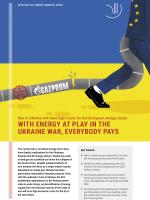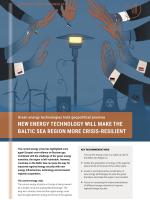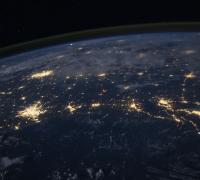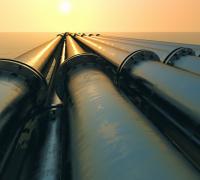With energy at play in the Ukraine war, everybody pays
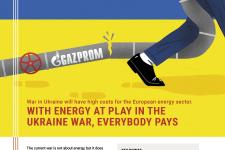
- War in Ukraine has prompted the EU to diversify its energy sources away from Russia.
- Ukraine has been cutting energy ties with Russia in the years leading up to the 2022 military invasion.
- Nord Stream pipelines that circumvented Ukraine as a transit state made the country more vulnerable both economically and politically.
- Diminishing the EU’s dependence on Russian gas following the 2022 war would be costly but could improve European security of supply in the long term.
Despite sustained efforts to turn towards the West, as a major transit country dependent on cheap gas, Ukraine has been particularly vulnerable to Russian pressure. Now, with the outbreak of war in Ukraine, the EU’s problematic dependence on the Russian petrol state is under stress, as diversification of energy supply from non-Russian sources in the wake of war will incur high economic costs for the EU in the near future.
The Russian attack on Ukraine has put the EU’s lenient policy towards Russia into question and has highlighted its problematic overdependence on Russian oil and gas. On the 12th day of the war in Ukraine, with Russia under tough Western sanctions, Russian Deputy Prime Minister Alexander Novak stated: ‘We have every right to take a matching decision and impose an embargo on gas pumping through the Nord Stream 1 gas pipeline.’
The International Energy Agency (IEA) has urged the EU neither to extend nor to sign new contracts with Gazprom. Meanwhile the EU is exploring policy options for diversification of gas supply. Russia currently supplies over 40% of the EU’s gas and nearly a third of its oil, leaving the EU exposed to economic and political pressure. Energy blackmail primarily concerns gas supply, as replacing Russian gas with other sources cannot be executed immediately due to insufficient gas infrastructure and market conditions (i.e. limited availability of liquified gas).
While oil can be transported by land and sea, meeting the EU’s energy demand will nevertheless require both diversification of energy supply routes and speeding up of its energy transition. This process will prove challenging and costly.
Phasing out the EU–Russia energy cooperation after the Russian invasion of Ukraine also marks a major shift in continental energy politics that affects all the parties. For Russia, the loss of the European market implies a huge loss of revenue and a deepening future dependence on China. Ukraine finds itself once again caught in the middle. For years Ukraine increasingly sought greater energy independence from Russia and deeper integration with the EU energy market.
Meanwhile, the construction of pipelines such as Nord Stream 2, circumventing Ukraine as a transit state for Russian gas, made Ukraine even more vulnerable because it sent a clear signal to Moscow that energy trade with Europe would not cease, even following the annexation of some Ukrainian territories by Russia in 2014. During the current war, Moscow is claiming that Russia is doing ‘everything in its power’ to keep the flows through Ukraine to the EU stable. However, the damage being done to Ukrainian energy infrastructure and its economy at large is still hard to estimate.
Ukraine: caught in energy geopolitics
Ukraine has been both politically and economically constrained by geopolitical forces since the collapse of the Soviet Union. Russian energy resources were utilised as a political tool to keep Ukraine in a state of dependency, for example through discounted gas prices. The gas crises in 2006 and 2009, when Ukraine’s dispute with Gazprom resulted in cut-offs of Russian gas supply to Europe, sparked revisions of the Ukrainian energy policy. In February 2011 Ukraine became a member of the Energy Community (EC) – an international organisation aimed at extending the EU’s internal energy market into third countries.
Russia continued exerting pressure, for example when, in November 2011, Gazprom offered cheaper gas in an attempt to pull Ukraine away from the EC. Ukraine’s new energy policy plans only accelerated after the 2014 conflict with Russia. The loss of coal-rich eastern regions (including the Donbas region), and the annexation of Crimea with its critical energy infrastructure (big scale solar power plants, as well as offshore oil and gas) put an additional strain on Ukraine’s energy security.
In March 2014 Moscow unilaterally terminated the 2010 Kharkiv Accords, which had provided a discounted gas price in exchange for the lease of a Ukrainian naval base in Sevastopol (in Crimea) until 2042. This resulted in an 83% gas price spike for Ukraine and triggered a serious policy debate on energy efficiency measures and diversification of the domestic energy portfolio to limit energy dependence on Russia to the absolute minimum.
…the construction of pipelines circumventing Ukraine, such as Nord Stream 2, sent a clear signal to Moscow that energy trade with Europe would not cease, even following the annexation of Ukrainian territories by Russia in 2014.
In this changed political context, the EC was in a stronger position to lobby for a more sustainable energy agenda in Ukraine. Ukraine’s new energy plans emphasised stronger energy efficiency measures, market liberalisation and investment in big renewable energy projects (i.e. solar and wind farms). Ukraine also outlined plans for further development of nuclear energy, as well as diversification of gas, including alternative supply routes and liquified natural gas (LNG) terminal.
Membership of the Energy Community was initially perceived by Ukraine as a factor that could improve its bargaining position with Moscow by, for example, helping to resolve some disputes with Russia, promoting Ukrainian interests and providing financial support for the modernisation of Ukraine’s energy infrastructure. However, being a rule-based system aimed primarily at market integration, the EC could not meet those expectations.
Following the 2014 conflict the Kremlin focused on the development of new gas pipelines (Turk Stream, Nord Stream 2), to diminish Ukraine’s significance as a transit country. As the network of both oil and gas pipelines crossing Ukraine gave it a certain leverage in conflicts with Russia, the development of Nord Stream 2 (NS2) was strongly opposed by the Ukrainian side.
Former Ukrainian President Petro Poroshenko actively campaigned against the establishment of NS2 in Brussels in 2018, as the Gazprom transit agreement with Ukraine was set to expire on 1 January 2020. He described the NS2 pipeline as ‘the Trojan horse for European security’ and a ‘political project against Ukraine’ with no economically justifiable basis.
Ukrainian politicians and journalists questioned the solidarity and motives of the EU players as it could be seen as a ‘political bribe for loyalty to Russia’, with the Ukrainian press highlighting Europe’s choice with headlines such as: ‘Values or Nord Stream 2?’
The cost of cutting energy ties with Russia
The Russian invasion of Ukraine has not only put a definitive stop to the Nord Stream 2 project but led to a hasty revision of the EU’s entire energy policy towards Russia. This task is challenging, as the EU must solve two riddles simultaneously: how to decrease the high dependence on Russian energy supply and how to stay true to its climate agenda.
In 2021 alone, the EU piped over 140 billion cubic meters (bcm) of Russian gas, with an additional 15 bcm reaching the EU in liquified natural gas (LNG) form. Several gas import contracts with Gazprom expire by the end of 2022 and other significant yearly volumes are contracted until 2030. Simultaneously, greenhouse gas emissions must be reduced by at least 55% from 1990 levels by 2030, following the European Green Deal aims. Therefore, while quick, short-term fixes such as burning coal would ease the situation, they run against the EU’s climate goals.
Considering this, the International Energy Agency has outlined a ten-point action plan to reduce the EU’s dependence on Russian gas by a third by the end of 2022 while adhering to the current climate agenda. The European Commission followed in the same tone with its new ‘REPowerEU’ plan for eliminating the EU’s dependence on Russian fossil fuels by 2030, starting with gas.
Severing energy ties with Russia would put a high economic strain on the EU in the short term but could accelerate the EU’s energy transition and boost its security of supply long term.
The measures outlined in both plans include diversification of gas supply, the introduction of minimum gas storage requirements, increased generation from low emission energy sources (e.g. bioenergy and nuclear), boosting energy efficiency measures, and accelerating development of wind and solar energy. However, the EU Versailles Declaration of 11 March 2022 that followed lacks urgency and credible execution plans, despite the EU’s ambitious goal to reduce gas imports from Russia by two thirds by the end of the year.
Emergency measures have already been invoked that seek to increase security of gas supply. For instance, gas supply from Norway has been boosted to full capacity in order to fill the EU’s storage to 90%. However, this is a short-term solution. Not only will the existing infrastructure need to undergo maintenance, but Norway cannot physically cover Russia’s gas share. Other alternatives include increasing imports through the Southern Gas Corridor from Azerbaijan and scaling up investment in domestic sources such as shale gas.
The diversification of gas supply will be also highly dependent on the LNG sector. Some countries have already heavily invested in LNG infrastructure (e.g. Lithuania & Poland), while others are currently developing such plans (e.g. Germany has announced that two LNG terminals will be built ‘ASAP’). Collectively, the EU’s overall LNG import capacity amounts to 157 bcm per year – enough to meet around 40% of its total gas demand.
In 2021 the gas imports through LNG utilised only half of this capacity (around 80 bcm), hence there is a potential to optimise it further. However, the majority of the LNG import terminals are relatively isolated and insufficiently connected to other EU states (e.g. in Spain). In the current circumstances – the war in Ukraine, worldwide panic buying of gas, a relatively inflexible LNG market constrained by long-term contracts and infrastructural limitations (restricting import and export flows), the price of LNG can only become increasingly high.
Coupled with the accelerated energy transition from fossil-based systems, the high prices will hit companies and individual consumers in Europe. The EU is seeking to mitigate this impact with a raft of emergency measures (i.e. the ‘Energy Prices Toolbox’) and long-term measures.
The wider outlook
On the Russian side, recovering from the lost share of gas exports to the EU will necessitate heavy investment in infrastructure to export additional gas volumes to China. In 2021 Russia exported 16.5 bcm to China and the volumes were expected to increase to 38 bcm by 2025. Considering the current climate, both volumes and timeline may accelerate. Even when the ‘strategic gas infrastructure’ to China is completed, the lost share of the EU’s gas volumes will not be fully recovered. Furthermore, the new power dynamics will make Russia highly dependent on Chinese demand.
Despite the notable gas market disruptions, in the short term Russia is likely to keep its revenues buoyant from oil sales by shipping the supply to non-EU markets. At the same time the EU will levy its restriction of Russian oil imports to the EU against replacement barrels from strategic reserves. While the release of emergency reserves cannot make up the permanent loss of the Russian oil volumes, it will play a crucial role in the months to come before alternative sources are secured.
The Secretary-General of OPEC noted that the world simply does not have enough capacity to replace Russian output. While it is possible to tap into oil supply from the US, Norway, Saudi Arabia etc. it will not cover the lost volume. The substitution of Russian oil has implications for many parties, most notably the Persian Gulf countries. The current release of the US strategic oil reserves may also have repercussions for US–Saudi relations. Although the Russian invasion of Ukraine may lead to another ‘catastrophe’ in the global oil market, the biggest oil cartel remains impartial regarding Russia’s position in the OPEC+ arrangement.
Severing energy ties with Russia would put a heavy economic strain on the EU in the short term but could accelerate the EU’s energy transition and boost its security of supply long term. Meanwhile, it leads to the increased dependency of Russia on China and significant loss of revenues, as the EU market cannot be quickly or easily replaced. However, the Versailles summit, which introduced short-term measures to phase out the EU’s dependence on Russian oil and gas, did not set specific deadlines nor a trajectory. The following weeks will show to what extent the EU will decide to cut itself off from Russian fossil fuel dependency. Failure to do so means the EU will continue to be exposed to Russian energy blackmail.
Illustration & layout Cecilie Castor von Sprekcelsen
DIIS Experts


